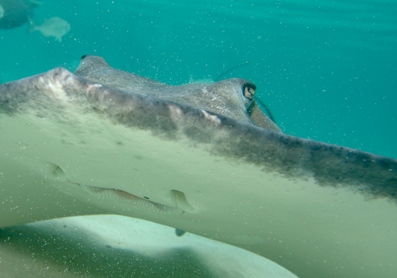Nutrition-
Stingray 'Sand'wich
 Southern Stingrays use their strong senses
to find their food in the sand. These senses include: smell,
touch, and electrosenses. This species usually feeds during the
night on crustaceans (such as
White Shrimp), bivalves, worms and small bottom-dwelling
fishes. To expose their prey, they flap their pelvic fins in the sand
leaving shallow craters. Then they are able to suck up the
organism into their mouths with their jaws. Once they
have their prey in their mouths, they crush the shells with their
multiple rows of teeth to get to the meat. After they have
gotten the meat, they spit the shell
out.
Southern Stingrays use their strong senses
to find their food in the sand. These senses include: smell,
touch, and electrosenses. This species usually feeds during the
night on crustaceans (such as
White Shrimp), bivalves, worms and small bottom-dwelling
fishes. To expose their prey, they flap their pelvic fins in the sand
leaving shallow craters. Then they are able to suck up the
organism into their mouths with their jaws. Once they
have their prey in their mouths, they crush the shells with their
multiple rows of teeth to get to the meat. After they have
gotten the meat, they spit the shell
out.
Since stingrays glide and lie on the seafloor, they are able to conserve energy. Stingrays also digest their food slowly. Sharks and fish have elongated intestines giving them more time to absorb nutrients. Their stomachs have rugae which are invaginations that increase its surface area. They also have a spiral valve that has ridges in a zig-zag pattern to increase surface area and nutrient uptake. These adaptations allow them to survive for long periods of time without eating. This gives the stingray more time to stay hidden from predators under the sand on the sea floor.
It's a nice day for a 'wet' wedding!
It's a
nice day to read about Reproduction
Return to Home Page